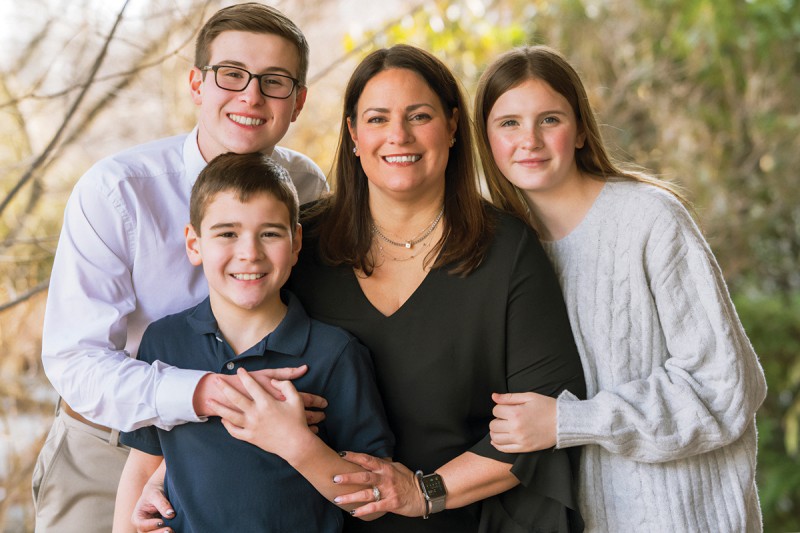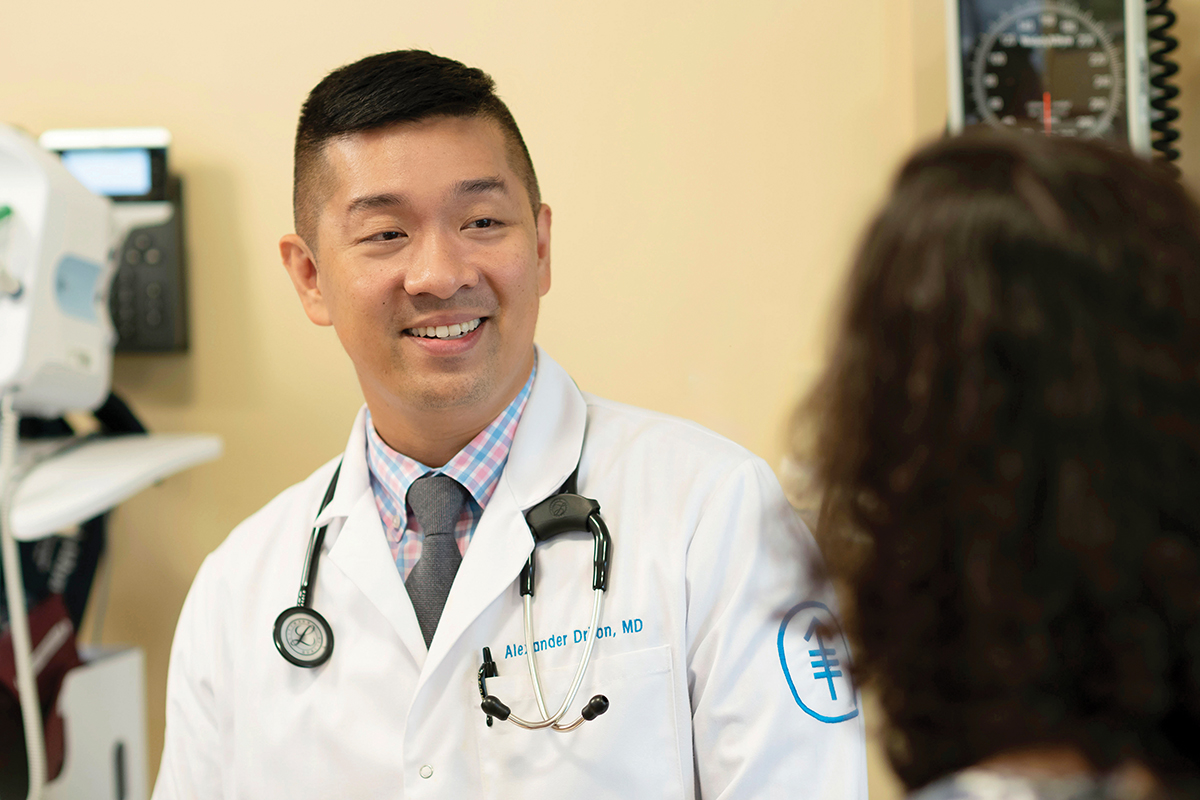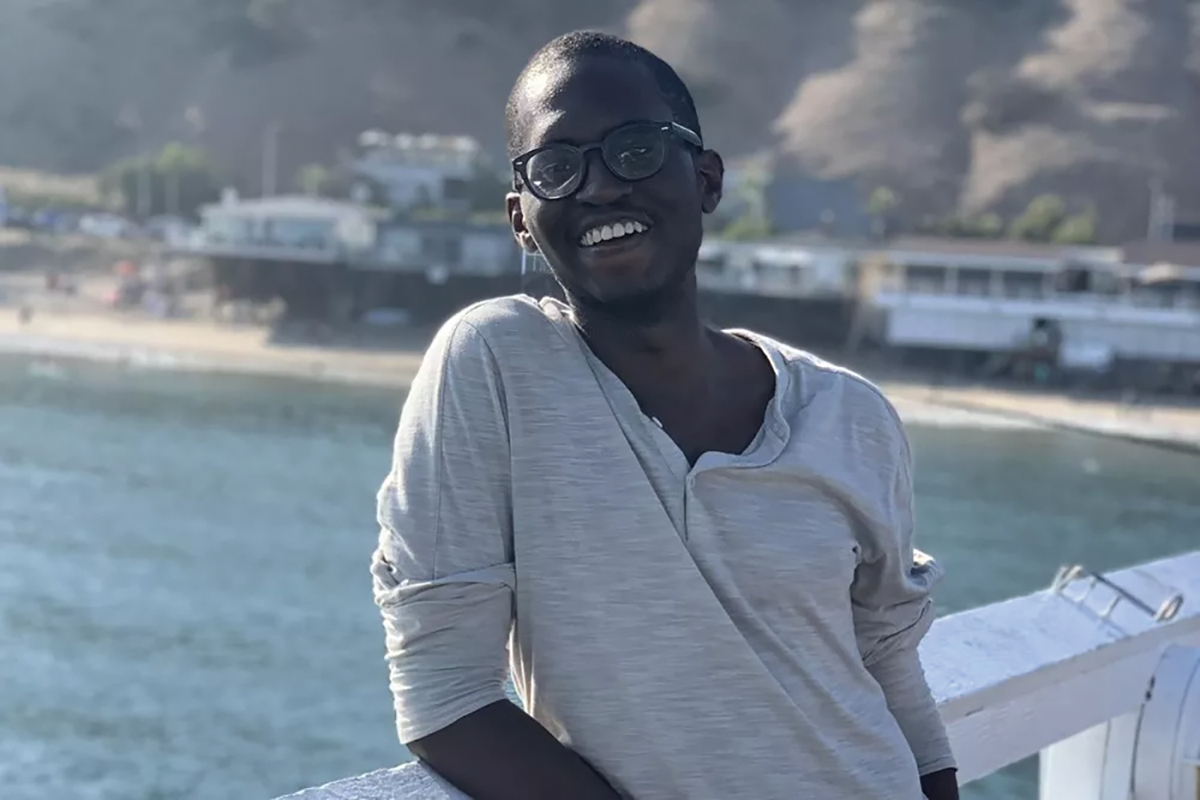
Jen Cosgrove says her first appointment at Memorial Sloan Kettering Cancer Center (MSK) was unforgettable.
“When my family and I showed up at MSK, we felt totally defeated,” she says. “We knew I had a type of lung cancer called adenocarcinoma — that was it.”
As a wife and mother in her 30s, she was deeply frightened, not just for herself but for her three children, all under the age of 9.
“At my first appointment at MSK, the care team sat with us for three and a half hours and went through my entire history, soup to nuts,” Jen says. “It was a hard conversation, because they were pretty sure I was stage 4, meaning the cancer had spread. That’s a hard pill to swallow because it’s not curable.”
But one thing she heard that day stood out. “The MSK doctors told me, ‘We have hope. Advances in research and treatment are happening right now that can help you.’ I felt encouraged for the first time, which was awesome.”
Hope Following an ALK Stage 4 Lung Cancer Diagnosis
MSK quickly established her precise diagnosis and uncovered crucial information about the cancer. “MSK called to tell me the cancer was ALK positive, and my mother and sister started crying with joy,” Jen recalls.

She and her family had done their research. Jen’s tumor had a mutation in a gene called ALK that was helping fuel the cancer. However, this type of mutation can be susceptible to a targeted therapy called alectinib that can slow the cancer’s growth.
Jen was prescribed alectinib by MSK thoracic medical oncologist Alexander Drilon, MD. He is a pioneering researcher of cancer-related mutations and Chief of the MSK Early Drug Development Service.
“When I started the drug, I couldn’t stand up,” Jen says. “Within four days I got off my couch and said, ‘Let’s take the kids to the arcade.’ It was like a switch flipped, and I have never looked back.”
What Matters: Being There for Her Children’s Milestones
The unparalleled combination of compassionate care, cutting-edge diagnostics, and world-class research is helping the experts at MSK rewrite the playbook for lung cancer.
For Jen, this has meant reaching milestones she feared were impossible when she learned she had metastatic lung cancer in 2017. “I’ve seen my kids enter high school and graduate middle school and move up in elementary school. I’ve been to their parties, and I run them all over for their sports and activities.”
“I just feel really lucky,” she says, “because with cancer your first shot is your best shot, and for me that came at MSK.”
Discovering a New Type of Lung Cancer in Nonsmokers: Atypical Small Cell Lung Carcinoma
Khaliq Sanda was a 19-year-old student at Duke University when he was diagnosed with small cell lung cancer, one of the two major types of lung cancer (the other is called non-small cell lung cancer). Like Jen, he was a never-smoker.

“That is very unusual,” says physician-scientist Charles Rudin, MD, PhD, who was one of Khaliq’s doctors. “This is a type of cancer that’s almost always associated with heavy smoking. So that prompted us to begin looking for other, similar examples of never-smokers with small cell lung cancer. We identified a group of patients who fit this pattern.”
The search for answers brought together 42 physicians and researchers across MSK — from the doctors who treat lung cancer to specialists in tumor genetics and computer analysis to pathologists, who evaluate cells and tissues to make a diagnosis.
How MSK Experts Identified a Rare Lung Cancer
Together, they found a rare, distinct subtype of lung cancer they dubbed “atypical small cell lung carcinoma.” The people facing this diagnosis were younger than typical small cell lung cancer patients, who average around 70 years old. And they reported smoking very lightly or never.
Doctors can diagnose atypical small cell lung carcinoma because it displays a genetic signature — a “shattering” of one or more chromosomes in the cancer cells. This unusual genomic change may point toward treatment strategies.
The Importance of Screening to Catch Lung Cancer Early
Tragically, the cancer that Khaliq confronted was too far advanced to stop, and he passed away. His case underscores the seriousness of lung cancer — which causes more deaths than any other type of cancer — as well as the need to constantly improve screening for the disease to catch it as early as possible.

“Screening is one of the best tools we have to identify lung cancer early,” says thoracic surgeon Alexis Chidi, MD, PhD, and Co- Director of the MSK Lung Cancer Screening Program.
“Our research teams are working diligently to find effective strategies to identify lung cancer early for people at risk, including those people who don’t meet current screening guidelines, which focus on people 50 to 80 years old who smoke or did in the past.”
Promising New, Noninvasive Techniques for Better Diagnosis of Lung Cancer
In 2024, MSK researchers made major strides in developing new methods that could one day transform lung cancer diagnosis.
The E-Nose Diagnostic Tool: Potential Radiation-Free Lung Cancer Screening
MSK thoracic surgeon Gaetano Rocco, MD, conducted a clinical trial that showed promising results for a screening method called “E-nose.” E-nose involves a person breathing into a collection device for three minutes to develop what’s called a “breathprint.” A highly sophisticated technology then “smells” the sample for chemicals called volatile organic compounds that are emitted by cancer cells.
“The E-nose was very accurate when compared with the long-established available imaging methods,” such as X-rays and CT and PET scans, says Dr. Rocco.

He believes that if the E-nose is fully developed, it may encourage more people who should get screened for lung cancer to do so, because the method “is noninvasive and inexpensive and could eventually be small enough to fit in a doctor’s pocket.”
Targeting the DLL3 Molecule, Present in Most Lung Cancers
MSK researchers also published research on a new imaging technique they developed that uses a radioactive particle that binds to a molecule on cancer cells called DLL3 and makes the cancer cells more visible on PET scans.
The technique was developed in the labs of MSK radiochemist Jason S. Lewis, PhD, and Dr. Rudin. “About 70% to 80% of small cell lung cancers express DLL3 at various levels,” Dr. Rudin says.
The technology could determine if a patient may be helped by drugs that target DLL3. And Dr. Rudin believes it may be possible to link the radioactive particle to other therapies “that could create an important new treatment option.”
Unlocking the Secrets of Stem Cells at Lung Cancer’s Beginning
At the Sloan Kettering Institute, the lab of Joo-Hyeon Lee, PhD, is exploring fundamental questions about the biology of the lung that can shed new light on lung cancer.
A major focus of her lab is stem cells. Stem cells keep lungs healthy by dividing to replace old or damaged lung cells. “We study how stem cells work to maintain and regenerate healthy tissue,” says Dr. Lee. “But we also know that when stem cells get dysregulated — which means something goes awry — that can lead to cancer as cells grow out of control. We investigate how stem cells work to understand what happens when things go wrong.”
Using Organoids to Study Lung Stem Cells
One way her team does this is using patient-derived organoids — miniature lungs grown in the lab using samples of a patient’s tissue. “They are like mini lungs, allowing us to study how cells communicate and work together to form and repair tissues or tumors,” explains Dr. Lee. “We also investigate how tumor cells compete with healthy cells for resources and change their environment to better support their growth.”
The lab’s research spans the full cycle of lung health — from healthy tissue maintenance to tumor development and back to healing after treatment. “Understanding how stem cells work in each of these stages is crucial,” says Dr. Lee. “This knowledge could help us develop better treatments for lung disease.”
Lifesaving Confidence
This depth and breadth of research, stretching from the lab to the clinic, gives Jen Cosgrove enormous confidence in her MSK team. Since her own diagnosis seven years ago, she has become a passionate advocate for lung cancer issues and someone who is deeply knowledgeable about the latest scientific advances.
“I trust my MSK team with my life — literally,” she says. “If the time comes that I need some other treatment, I know they’ll help me. They’re like my family now. And I so appreciate it.”
Dr. Drilon’s research is supported by the MSK donor community, including Keren Phillips and Deborah Kazis-Taylor for the Earle and Judy Kazis Foundation Fund and The Gibbons Scattone Family Foundation.
Dr. Rudin’s research is supported by the MSK donor community, including Ge Li & Ning Zhao Family Foundation, Stand Up To Cancer, Goldberg Family Foundation, Inc., and Robert J. Kleberg, Jr. and Helen C. Kleberg Foundation.
Dr. Lewis’ research is supported by the MSK donor community, including The Tow Foundation.
Dr. Rudin holds the Sylvia Hassenfeld Chair in Lung Cancer Research.
Dr. Lewis holds the Emily Tow Chair in Oncology.